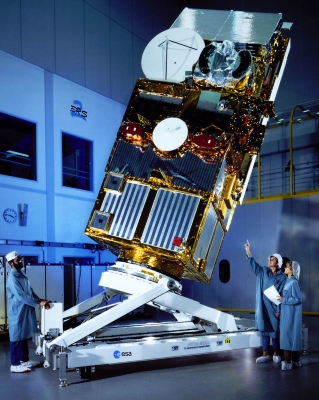MWR (ERS) Overview
Applications

The main purpose of the ERS microwave radiometer (MWR) was the measurement of the tropospheric path delay for the altimeter. It did this through the measurement of the atmospheric-integrated water vapour content and the estimate of the attenuation of the altimetric signal by the liquid water content of the clouds. This was achieved by measuring the brightness temperature at 23.8 and 36.5 GHz which were, over ocean, very sensitive to the content of water vapour and liquid water in the troposphere. The water vapour was related to the excess path length as the liquid water was to the attenuation. The relation between brightness temperature and geophysical parameters, i.e. liquid water and water vapour, was of statistical nature and was obtained by linear regression using a radiative transfer mode.
The MWR was operationally devoted to the determination of the wet tropospheric Radar Altimeter path delay. However, the two poles were the only places where the MWR could be used to map radiometric properties. The sea-ice and ice-shelf there, have a slower time evolution than the ocean (the contribution of which was related to the wind), and the very dry atmosphere adds only a very small contribution to the signal.
Design

The MWR was an imaging multi-spectral radiometer (passive microwave). In order to eliminate Earth's irradiation, differential measurements at two frequencies had to be performed. The optimal frequency setting was achieved by using one frequency at the maximum and one at minimum attenuation. Each channel, 23.8 and 36.5 GHz had one feed horn and the MWR points via an offset reflector at an angle close to nadir. The instrument configuration was chosen such that the 23.8 GHz channel was pointing in the forward direction, the 36.5 GHz channel in the backward direction with a footprint of about 20 km diameter for each beam.
It had a bandwidth of ±200 MHz wide and operated in Dicke mode by comparing the antenna temperature to an internal reference source with a switching frequency of 1 KHz. The frequencies were the result of a trade off between instrument (reflector) size required to cover a horizontal area on the Earth surface comparable to the RA-2 beam and the maximum sensitivity to water vapour change in the atmosphere. The output signal from the sensor was integrated and sampled every 150 ms (synchronised with the Infra-red Radiometer scan rate), and was transmitted to the ground as a numerical count together with the temperatures of the microwave components.
Technical Characteristics
- Accuracy: Temparature: 2.6 K
- Spatial Resolution: 20 km
- Swath Width: 20 km
- Waveband: Microwave: 23.8 and 36.5 GHz